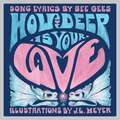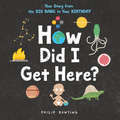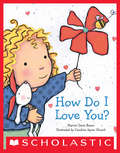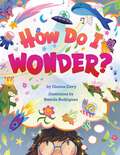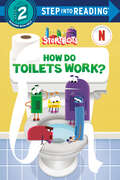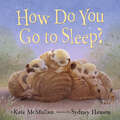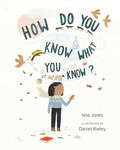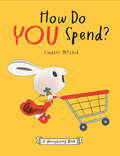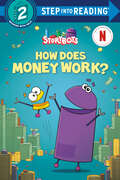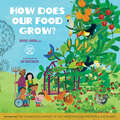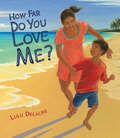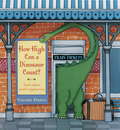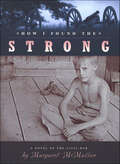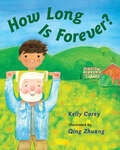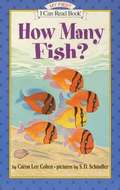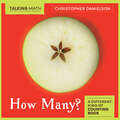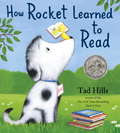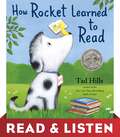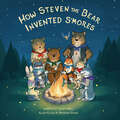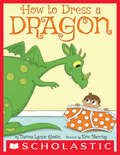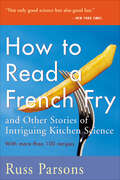- Table View
- List View
How Deep Is Your Love: A Children's Picture Book
by Bee GeesA majestic picture book based on the Bee Gees's classic love song "How deep is your love? I really mean to learn 'Cause we're living in a world of fools Breaking us down When they all should let us be We belong to you and me . . ." How Deep Is Your Love is a fantastical picture book based on one of the Bee Gees's biggest hits. The song topped the Billboard Hot 100 chart, remaining in the top ten for seventeen weeks, and won the band's first of eight GRAMMY awards. With lyrics by the Bee Gees and illustrations by J.L. Meyer, the picture book tells the tale of two bunny mermaids who meet on a rock and descend into the water together. As the bunnies escape traps, skirt around nets and hooks, and protect each other in this thrilling adventure, they realize how deep their love is. Meyer's imaginative story compliments the hit song perfectly and will delight children and adults alike.
How Deep Is the Ocean? (Let's-Read-and-Find-Out Science 2)
by Kathleen Weidner ZoehfeldRead and find out about the deepest part of the ocean in this colorfully illustrated nonfiction picture book.The ocean covers almost three-quarters of the Earth, but how deep does it go? Put on your scuba gear and explore the ocean, from its shallowest waters to its deepest, most mysterious parts. As you dive deeper, you’ll discover glowing animals, strange creatures that don’t need sunlight to survive, and even the largest hunter in the world.With beautiful illustrations and engaging text, How Deep Is the Ocean? will guide young readers into the deepest parts of the ocean. Featuring a find-out-more section with a water-pressure experiment, a lesson in making a sounding line to learn how scientists measure the depth of the ocean, a glossary of new terms, and web research prompts, this book will begin children’s explorations of the deep sea. Both the text and the artwork were vetted for accuracy by Dr. David Gruber, real-life deep sea explorer and professor of biology and environmental science at Baruch College.This is a clear and appealing science book for early elementary age kids, both at home and in the classroom. It's a Level 2 Let's-Read-and-Find-Out, which means the book explores more challenging concepts for children in the primary grades. The 100+ titles in this leading nonfiction series are:hands-on and visualacclaimed and trustedgreat for classroomsTop 10 reasons to love LRFOs:Entertain and educate at the same timeHave appealing, child-centered topicsDevelopmentally appropriate for emerging readersFocused; answering questions instead of using survey approachEmploy engaging picture book quality illustrationsUse simple charts and graphics to improve visual literacy skillsFeature hands-on activities to engage young scientistsMeet national science education standardsWritten/illustrated by award-winning authors/illustrators & vetted by an expert in the fieldOver 130 titles in print, meeting a wide range of kids' scientific interestsBooks in this series support the Common Core Learning Standards, Next Generation Science Standards, and the Science, Technology, Engineering, and Math (STEM) standards. Let's-Read-and-Find-Out is the winner of the American Association for the Advancement of Science/Subaru Science Books & Films Prize for Outstanding Science Series.
How Did Humans Go Extinct?
by Paul Hoppe Johnny MarcianoLet’s learn about the most mystifying species to ever walk the Earth!“A clever . . . way to bring awareness to the very real threats to humanity posed by war, climate change, and capitalism. A compelling and unique dystopian sci-fi picture book for early school age readers, this is recommended for all collections.” —School Library JournalPlib is like every other Nøørfbløøk kid on Earth, except for one thing.He loves humans—those horrible, terrifying monsters who dominated the planet ten million years ago.Only one thing about the humans bothers Plib. What happened to them all? Did they turn the planet into an uninhabitable wasteland? Or did they turn on each other? Or did the humans die out because of something else they did—or didn’t—do?Find the answer in How Did Humans Go Extinct?
How Did I Get Here?: Your Story from the Big Bang to Your Birthday
by Philip BuntingFrom the Big Bang to your birthday, and (almost) everything in between, this funny and informative book tells your story.You are one of the newest members of a family tree that goes way, way, way back to the very first life on Earth. A lot of incredible things had to happen between the beginning of the universe and today in order to make you. The fact that you (and everyone you know) are here is nothing short of mind-boggling! Read this book to discover how it happened, and prepare to be amazed by the awesomeness of you.This clever, funny, and scientific timeline of the journey of human existence is designed to get young readers asking questions, finding answers, and marveling at the many wonders of our world, from the Big Bang, to evolution, to a brand-new baby, and more.
How Do I Love You?
by Marion Dane BauerA rhyming story about a parent's unlimited love for a child -- in the same format as the bestselling book I Love You Through and Through, and with pictures by the same illustrator."How do I love you? Let me count the ways.I love you as the sun loves the bright blue days . . ."In this padded board book, a parent declares her love...as the bees love a flower, a duck loves a shower, a bird loves to sing, a bear loves the spring. Written by Newbery-award-winning author Marion Dane Bauer, inspired by the poem by Elizabeth Barrett Browning, and with pictures by Caroline Jayne Church, illustrator of the bestselling I Love You Through and Through.
How Do I Wonder?
by Gianna DavyThrough lyrical text and vivid images, How Do I Wonder? invites young readers to open the door to their miraculous minds, exploring the wacky and wonderful 'What-ifs' and 'Whys' of the world around—and within—them."A thought-provoking tale with a much-needed message: The mind is a place of limitless wonders."—Kirkus Reviews A book can be a powerful tool to spark creativity and imagination. Do snails view turtles as slow? Why is water wet? From the author of No One Owns the Colors comes an entertaining and beautifully illustrated picture book that shows children how to ask questions that help them see the world in a different way. Written and illustrated for all children, each page showcases a diverse and engaging world and helps kids ages 4-8 develop a growth mindset. Let the silly prompts show how the joy of a simple question can entertain the mind and spirit, no matter where you happen to be. • Curriculum Connection—Creative prompts help open up pathways to discovery and spark a catalyst to classroom engagement. • Infinite Curiosity—Teach the innate sense of wonder that demonstrates joy is everywhere, not just in a certain place. • Evocative Words—The lyrical text is entertaining to read and the vivid imagery helps keep the curiosity in children flowing. Start helping your little ones see the world in a new way with How Do I Wonder?
How Do Toilets Work? (Step into Reading)
by Random HouseThe robots from Netflix's Ask the StoryBots star in an all-new Step 2 Step into Reading leveled reader about how toilets work.We use the toilet every day, but how does it work—and where does our waste go? Join the StoryBots for an amazing adventure into the toilet, through the plumbing, and beyond. What they learn will fascinate children ages 4 to 6 who love Netflix's educational show.Step 2 Readers use basic vocabulary and short sentences to tell simple stories. For children who recognize familiar words and can sound out new words with help. Check out the other book in the series:Tyrannosaurus RexTriceratopsVelociraptorsThe Moon&’s Turn to ShineStop That Virus!
How Do You Go to Sleep?
by Kate McMullanDiscover how different animals go to sleep in this rhyming picture book from a veteran children's author! Follow along as three children learn about the bedtime routines of squirrels, parrots, dolphins, and many more. Meerkats sleep in a stack. Is that how these kids go to sleep? Or do they hibernate in snow all winter long like frogs? Or maybe they sleep the day away like skunks? No, that can't be right! By the book's conclusion, the kids have imitated all kinds of animals who are portrayed sleeping in their natural habitats, thanks to Sydney Hanson's charming illustrations. Readers will recognize the way the human child eventually goes to sleep--with stuffed animals, a bedtime story, and a kiss good night!A Bank Street Best Book of the Year "Punctuated with zaniness, McMullan's litany nevertheless offers a quiet, calming rhythm to help little ones nod off."--Kirkus"A bedtime book that will soothe and please children and caregivers."--SLJ"A nice pairing with Diane Muldrow's How Do Giraffes Take Naps?, Vin Vogel's Bedtime for Yeti, or Cari Best&’s I&’m Brave! I&’m Strong! I&’m Five!, particularly for little ones looking for comfort around sleeping in their own beds."--Booklist
How Do You Know What You Know?
by Noa JonesA charming and inquisitive story that celebrates tracing the origin of ideas, language, and every day objects, for children 4–8.Where does snow come from? What language did the word thermos come from? And who was the Buddha's teacher?So many problems in the world come from accepting information at face value without looking into where it comes from. How Do You Know What You Know? follows a child and their father on a cozy, snowy day outing. The child asks questions about how things came to be the way they are. The questions range from how the father knows how to tie a shoe to why it&’s not a good idea to eat yellow snow. These queries are met by the father with patience and humor that weave a delightful narrative of intergenerational knowledge sharing. In this exchange, respectful inquiry is beautifully modeled for young learners.The journey includes an amble in the park, a trip to the library, a bus ride, and a visit to a local Buddhist temple where the father is a student. The teacher there introduces the child to the idea of lineage, that wisdom and understanding comes from generations of knowledge passed down from person to person. With a quaint and welcoming simplicity, the illustrations bring this beautiful story to life, and every spread has a subtle nod to the progression of how things come to be the way they are. The story encourages children&’s natural curiosity and shows them that everywhere they look there is a story to be told if we just ask.
How Do You Spend? A Moneybunny Book (A Moneybunny Book)
by Cinders McLeodCelebrate the many different ways a little bunny can spend her savings, and learn about opposites too!Bun has been saving her carrots, and now it&’s time to spend some—but HOW will she spend them? Well, she could spend fast and buy a lot of things all at once, or she could take her time and spend slowly on something unique. She could buy something ordinary like a toothbrush, or something exciting like a mini sports car. Then there are things to buy for herself and things to buy for others, as well as things she needs and some that she wants. There are so many options, and little bunnies will have a ball considering them all!
How Do You Take a Bath?
by Kate McMullanPerfect for fans of Five Little Monkeys Jump in the Bath, this fun and educational picture book brings together adorable baby animals and bathtime.How do YOU take a bath? Does your mama comb your fur?Do you shake off all your dirt?Do you splash and flap and quack?Do the birdies peck your back?No!Follow elephants, pigs, monkeys, hippos, and more in this charming rhyming picture book from veteran author Kate McMullan. How does a pig take a bath? It sinks in the mud! What about a chicken? It thrashes about in dust! And a cat? Why, it licks itself clean, of course! Sydney Hanson's adorable illustrations toggle neatly between animals in nature grooming themselves and humorous depictions of children attempting the animals' bathing tactics. By the end of the book, the child finally makes his way to the bathtub, no mud baths or lick baths about it!
How Does Money Work? (Step into Reading)
by Scott EmmonsThe robots from Netflix's StoryBots Answer Time star in an all-new Step 2 Step into Reading leveled reader!Bing wants to know what money is and why we use it. His questions lead him from a bank to a tour of a successful lemonade stand. What he learns will fascinate children ages 4 to 6 who love Netflix's educational show.Step 2 Readers use basic vocabulary and short sentences to tell simple stories. For children who recognize familiar words and can sound out new words with help.
How Does Our Food Grow
by Brooke JordenFruits and vegetables all taste great, but how did they end up on your plate? The fresh and colorful foods you know came from farms—that&’s where they grow! Some grow underground and some hang from trees. Can you find them all? Let&’s look and see! Every fruit, vegetable, grain, and legume has its own story: Where do they grow? How do they taste? And how do they impact our bodies and the world around us? In cooperation with Kitchen Connection, an organization committed to improving our food system through education, this colorful picture book introduces readers to the concepts of biodiversity, reducing food waste, and proper growing conditions for different crops in simple, accessible language. With cool facts and challenges throughout, fun rhyming verse, and charming illustrations, How Does Our Food Grow? tells the stories of more than a dozen of your favorite fresh foods. Knowing that our food choices make a difference in our health and the health of our planet empowers us to choose wisely. The more we know, the better we grow.
How Far Do You Love Me?
by Lulu DelacreThis unique bedtime book by award-winning author-illustrator Lulu Delacre features a game that highlights the universal love between caregivers and children while taking readers on a journey across the seven continents of Earth.How far do you love me?I love you to the top of the peakslit by the morning sun ...To the crests of the desert where the wind sweeps sand from the dunes ... Based on a bedtime game that author-illustrator Lulu Delacre played with her young daughters, How Far Do You Love Me? is an "I love you" book with a twist. With every expression of love, readers visit a different location around the world, each a beautifully illustrated scene of caregivers and children in a place of natural beauty. The intimate size of the book is just right for sharing and snuggling up close with a child. As bedtime--or any quiet time--approaches, gather close with a special person in your life and get ready to let your imagination soar to place after place as you embark on a game of "How far do you love me?" The possibilities are endless!
How High Can a Dinosaur Count?: ...and Other Math Mysteries
by Valorie FisherBelieve it or not, once Bessie balanced a tower of 8 beets. But today, when she tries to balance 8 beets . . . 3 fall. How many beets does Bessie balance today?A clever text and imaginative art mesh to create playful, simple math problems right on target for ages 5-99 . . . anyone who loves the magic of numbers! In this School Library Journal Best Book of the Year, budding young mathematicians can help Heloise add her dimes, nickels, and pennies to see which hat in Madame Millie's Hat Shop she can buy. Or they can tell time with Lulu at the Tutti-Frutti Zoo, where Lollipop Licking begins at 9:00 sharp.From the Hardcover edition.
How I Found the Strong
by Margaret McMullanIt is the spring of 1861, and the serenity of Smith County, Mississippi, has been shattered by Abraham Lincoln’s declaration of war on the South. Young and old are taking up arms and marching off to war. But not ten-year-old Frank Russell. Although he is eager to enlist in the Confederate army, he is not allowed. He is too young, too skinny, too weak. After all, he’s just “Shanks,” the baby of the Russell family. War has a way of taking things away from a person, mercilessly. And this war takes from Frank a mighty sum. It’s nabbed his Pa and older brother. It’s stolen his grandfather, his grandmother. It has robbed Frank of a simpler way of life, food, his boyhood. And gone are his idealistic dreams of heroic battles and hard-fought victories. Now all that replaces those images are questions: Will I ever see my father and brother again? Why are we fighting this war? Are we fighting for the wrong reasons? Will things ever be the same around here?
How Long Is Forever?
by Kelly CareyFans of Guess How Much I Love You will love figuring out how long forever is alongside Mason and Grandpa.Mason is waiting for Nana's blueberry pie and complains that it's taking forever. So Grandpa challenges him to figure out how long forever really is. Is it as long as Grandpa has had his tractor? No. As long as it took Nana to grow the roses to the top of the chimney? Not even close. After a trip around the farm to figure out the answer, Nana's pie is ready. And Mason's finally got the answer: forever is how long he'll love Nana's pie and how long he'll love Nana and Grandpa, too.
How Many Fish? (I Can Read! #My First Shared Reading)
by Caron Lee CohenA story of six fish and six feet interact underneath the water. When one fish gets lost under a bucket, the feet unknowingly saves the fish.
How Many? (Talking Math Ser.)
by Christopher DanielsonTalking math with your child is fun and easy with this better approach to counting!Written by a math educator, this innovative book encourages critical thinking and sparks memorable mathematical conversations. You and your child decide what to count on each page. You have many choices, and the longer you look, the more possibilities you'll notice. There are no wrong answers in this book. As long as you're talking about what you see, think, and wonder, you're talking math!
How Mountains Are Made (Let's-Read-and-Find-Out Science 2)
by Kathleen Weidner ZoehfeldRead and find out about how mountains are made in this colorfully illustrated nonfiction picture book.A mountain might be thousands of feet high, but it can still grow taller or shorter each year. This classic picture book explores how mountains are made—including how Mount Everest grew from a flat plain under an ocean to become 29,028 feet tall.How Mountains Are Made features simple activities and fascinating cross-sections of the earth’s moving crust that clearly explain plate tectonics. Both text and artwork were vetted for accuracy by an expert in the field.This is a clear and appealing science book for early elementary age kids, both at home and in the classroom. It's a Level 2 Let's-Read-and-Find-Out, which means the book explores more challenging concepts for children in the primary grades. The 100+ titles in this leading nonfiction series are:hands-on and visualacclaimed and trustedgreat for classroomsTop 10 reasons to love LRFOs:Entertain and educate at the same timeHave appealing, child-centered topicsDevelopmentally appropriate for emerging readersFocused; answering questions instead of using survey approachEmploy engaging picture book quality illustrationsUse simple charts and graphics to improve visual literacy skillsFeature hands-on activities to engage young scientistsMeet national science education standardsWritten/illustrated by award-winning authors/illustrators & vetted by an expert in the fieldOver 130 titles in print, meeting a wide range of kids' scientific interestsBooks in this series support the Common Core Learning Standards, Next Generation Science Standards, and the Science, Technology, Engineering, and Math (STEM) standards. Let's-Read-and-Find-Out is the winner of the American Association for the Advancement of Science/Subaru Science Books & Films Prize for Outstanding Science Series.
How Rocket Learned to Read (Rocket)
by Tad HillsThis sweet picture book starring an irresistible dog named Rocket and his teacher, a little yellow bird, is perfect for back-to-school! Follow along as Rocket masters the alphabet, sounds out words, and finally . . . learns to read all on his own. With a story that makes reading fun-and will even help listeners learn to read-this book is ideal for kindergarten classrooms and story hour or as a gift for that beginning reader. Fresh, charming art by Tad Hills, theNew York Timesbestselling author/illu...
How Rocket Learned to Read: Read & Listen Edition (Rocket)
by Tad HillsLearn to read with this Read & Listen edition of the New York Times bestselling picture book, starring an irresistible dog named Rocket and his teacher, a little yellow bird. Follow along as Rocket masters the alphabet, sounds out words, and finally . . . learns to read all on his own!With a story that makes reading fun—and will even help listeners learn to read—this book is ideal for kindergarten classrooms and story hour or as a gift for that beginning reader. Fresh, charming art by Tad Hills, the New York Times bestselling author-illustrator of Duck & Goose, will make this a favorite.This ebook includes Read & Listen audio narration.
How Steven the Bear Invented S'mores (Steven the Bear)
by Scott HallHow Steven the Bear Invented S’mores is a read aloud picture book with fun life lessons and colorful illustrations. Steven the Bear and his friends are excited to go on their very first camping adventure. After being sure to pack and prepare well, the Bear Bunch heads out to find the perfect campsite. They set up camp and spend their day hiking, bird watching, and finding animals. After a day full of fun, Steven and the Bear Bunch sit down to toast marshmallows. That’s when Steven has a brilliant idea…? Join Steven the Bear and his friends in this first of many adventures!
How To Dress a Dragon
by Thelma Lynne GodinThis fantastical story about a little boy trying to dress his pet dragon is heartwarming, imaginative, and full of laughs! If you have to dress a dragon, you must be prepared to catch him as he flies by. Also, beware of ticklish toes, shirts with buttons, and hats that do not fit neatly between his horns! In this charming, second-person narrative, our little boy hero imparts his infinite knowledge of how to dress a dragon, a task that isn't quite as easy as it may seem. With helpful hints like, You may have to tickle-tackle him to the floor and give him belly kisses, and warnings like, Dragons do not like shirts. But they do like capes ! this story is not only delightfully entertaining, but extremely endearing. Author Thelma Lynne Godin and illustrator Eric Barclay come together perfectly to bring this fantasy to life!
How To Read A French Fry and Other Stories of Intriguing Kitchen Science: And Other Stories of Intriguing Kitchen Science
by Russ ParsonsWhy can you stick your hand into a 450-degree oven but not into 212-degree boiling water without burning it? Why does fish taste different from meat? Why do you cook pork differently from beef? Why should you always start cooking dried beans in cold water, not warm? Why should you never cook a Vidalia onion? What's the only kind of marinade that&’s really an effective tenderizer? Why is strawberry-rhubarb a good combination, scientifically speaking? And why don&’t potatoes fried in fresh oil ever brown completely, no matter how long they're cooked? &“Cooking is full of questions that science can help you answer, questions that can make you a better cook,&” writes the award-winning Los Angeles Times food editor, Russ Parsons. In this entertaining book packed with fascinating tidbits, Parsons explores the science behind such basic cooking methods as chopping, mixing, frying, roasting, boiling, and baking. You&’ll learn why soaking beans can&’t offset their gaseous effects, why green vegetables shouldn&’t be cooked under a lid for long, which fruits you can buy unripe and which you should buy fully ripened, which thickener to choose for your turkey gravy, and which piecrust is foolproof for a beginner. Along the way, Parsons slips in hundreds of cooking tips, provocative trivia, and touches of wit that make his scientific explanations go down smoothly. He also includes more than a hundred recipes that deliciously exemplify the principles he describes, from Tuscan Potato Chips and Crisp-Skinned Salmon on Creamy Leeks and Cabbage to Chocolate Pots de Creme and Ultimate Strawberry Shortcake.
